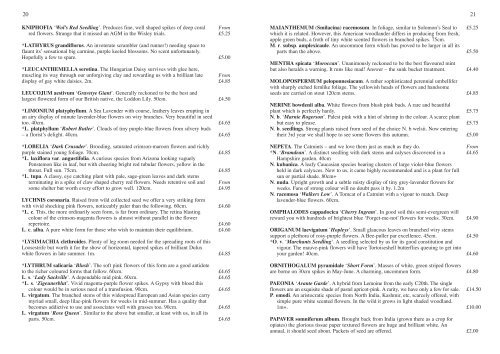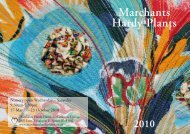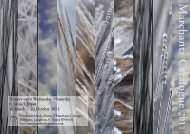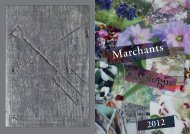download our catalogue free in pdf format here - Marchants Hardy ...
download our catalogue free in pdf format here - Marchants Hardy ...
download our catalogue free in pdf format here - Marchants Hardy ...
Create successful ePaper yourself
Turn your PDF publications into a flip-book with our unique Google optimized e-Paper software.
20<br />
21<br />
KNIPHOFIA ‘Wol’s Red Seedl<strong>in</strong>g’. Produces f<strong>in</strong>e, well shaped spikes of deep coral<br />
red flowers. Strange that it missed an AGM <strong>in</strong> the Wisley trials.<br />
*LATHYRUS grandiflorus. An <strong>in</strong>veterate scrambler (and runner!) need<strong>in</strong>g space to<br />
flaunt its’ sensational big carm<strong>in</strong>e, purple keeled blossoms. No scent unfortunately.<br />
Hopefully a few to spare.<br />
*LEUCANTHEMELLA serot<strong>in</strong>a. The Hungarian Daisy survives with glee <strong>here</strong>,<br />
muscl<strong>in</strong>g its way through <strong>our</strong> unforgiv<strong>in</strong>g clay and reward<strong>in</strong>g us with a brilliant late<br />
display of gay white daisies. 2m.<br />
LEUCOJUM aestivum ‘Gravetye Giant’. Generally reckoned to be the best and<br />
largest flowered form of <strong>our</strong> British native, the Loddon Lily. 50cm.<br />
*LIMONIUM platyphyllum. A Sea Lavender with c<strong>our</strong>se, leathery leaves erupt<strong>in</strong>g <strong>in</strong><br />
an airy display of m<strong>in</strong>ute lavender-blue flowers on wiry branches. Very beautiful <strong>in</strong> seed<br />
too. 40cm.<br />
*L. platphyllum ‘Robert Butler’. Clouds of t<strong>in</strong>y purple-blue flowers from silvery buds<br />
– a florist’s delight. 40cm.<br />
From<br />
£5.25<br />
£5.00<br />
From<br />
£4.85<br />
£4.50<br />
£4.65<br />
£4.65<br />
MAIANTHEMUM (Smilac<strong>in</strong>a) racemosum. In foliage, similar to Solomon’s Seal to<br />
which it is related. However, this American woodlander differs <strong>in</strong> produc<strong>in</strong>g from fresh,<br />
apple green buds, a froth of t<strong>in</strong>y white scented flowers <strong>in</strong> branched spikes. 75cm.<br />
M. r. subsp. amplexicaule. An uncommon form which has proved to be larger <strong>in</strong> all its<br />
parts than the above.<br />
MENTHA spicata ‘Moroccan’. Unanimously reckoned to be the best flav<strong>our</strong>ed m<strong>in</strong>t<br />
but also heralds a warn<strong>in</strong>g. It runs like mad! Answer – the sunk bucket treatment.<br />
MOLOPOSPERMUM peloponnesiacum. A rather sophisticated perennial umbellifer<br />
with sharply etched fernlike foliage. The yellowish heads of flowers and handsome<br />
seeds are carried on stout 120cm stems.<br />
NERINE bowdenii alba. White flowers from blush p<strong>in</strong>k buds. A rare and beautiful<br />
plant which is perfectly hardy.<br />
N. b. ‘Marnie Rogerson’. Palest p<strong>in</strong>k with a h<strong>in</strong>t of shrimp <strong>in</strong> the col<strong>our</strong>. A scarce plant<br />
but easy to please.<br />
N. b. seedl<strong>in</strong>gs. Strong plants raised from seed of the choice N. b welsii. Now enter<strong>in</strong>g<br />
their 3rd year we shall hope to see some flowers this autumn.<br />
£5.25<br />
£5.50<br />
£4.40<br />
£4.85<br />
£5.75<br />
£5.75<br />
£5.00<br />
*LOBELIA ‘Dark Crusader’. Brood<strong>in</strong>g, saturated crimson-maroon flowers and richly<br />
purple sta<strong>in</strong>ed young foliage. 70cm.<br />
*L. laxiflora var. angustifolia. A curious species from Arizona look<strong>in</strong>g vaguely<br />
Penstemon like <strong>in</strong> leaf, but with cheer<strong>in</strong>g bright red tubular flowers, yellow <strong>in</strong> the<br />
throat. Full sun. 75cm.<br />
*L. tupa. A classy, eye catch<strong>in</strong>g plant with pale, sage-green leaves and dark stems<br />
term<strong>in</strong>at<strong>in</strong>g <strong>in</strong> a spike of claw shaped cherry red flowers. Needs retentive soil and<br />
some shelter but worth every effort to grow well. 120cm.<br />
LYCHNIS coronaria. Raised from wild collected seed we offer a very strik<strong>in</strong>g form<br />
with vivid shock<strong>in</strong>g p<strong>in</strong>k flowers, noticeably paler than the follow<strong>in</strong>g. 60cm.<br />
*L. c. This, the more ord<strong>in</strong>arily seen form, is far from ord<strong>in</strong>ary. The ret<strong>in</strong>a blast<strong>in</strong>g<br />
col<strong>our</strong> of the crimson-magenta flowers is almost without parallel <strong>in</strong> the flower<br />
repertoire.<br />
L. c. alba. A pure white form for those who wish to ma<strong>in</strong>ta<strong>in</strong> their equilibrium.<br />
*LYSIMACHIA clethroides. Plenty of leg room needed for the spread<strong>in</strong>g roots of this<br />
Loosestrife but worth it for the show of horizontal, tapered spikes of brilliant Dulux<br />
white flowers <strong>in</strong> late summer. 1m.<br />
£4.85<br />
£4.85<br />
From<br />
£4.95<br />
£4.60<br />
£4.60<br />
£4.60<br />
£4.85<br />
NEPETA. The Catm<strong>in</strong>ts – and we love them just as much as they do.<br />
*N. ‘Bramdean’. A dist<strong>in</strong>ct seedl<strong>in</strong>g with dark stems and calyxes discovered <strong>in</strong> a<br />
Hampshire garden. 40cm<br />
N. kubanica. A leafy Caucasian species bear<strong>in</strong>g clusters of large violet-blue flowers<br />
held <strong>in</strong> dark calyxces. New to us, it came highly recommended and is a plant for full<br />
sun or partial shade. 80cm+<br />
N. nuda. Upright growth and a subtle misty display of t<strong>in</strong>y grey-lavender flowers for<br />
weeks. Fans of strong col<strong>our</strong> will no doubt pass it by. 1.2m<br />
N. racemosa ‘Walkers Low’. A Tomcat of a Catm<strong>in</strong>t with a vig<strong>our</strong> to match. Deep<br />
lavender-blue flowers. 60cm.<br />
OMPHALODES cappadocica ‘Cherry Ingram’. In good soil this semi-evergreen will<br />
reward you with hundreds of brightest blue ‘Forget-me-not’ flowers for weeks. 30cm.<br />
ORIGANUM laevigatum ‘Hopleys’. Small glaucous leaves on branched wiry stems<br />
support a plethora of rosy-purple flowers. A Bee-puller par excellence. 45cm.<br />
*O. v. ‘<strong>Marchants</strong> Seedl<strong>in</strong>g’. A seedl<strong>in</strong>g selected by us for its good constitution and<br />
vig<strong>our</strong>. The mauve-p<strong>in</strong>k flowers will have Tortoiseshell butterflies queu<strong>in</strong>g to get <strong>in</strong>to<br />
y<strong>our</strong> garden! 40cm.<br />
From<br />
£4.65<br />
£4.90<br />
£4.50<br />
£4.60<br />
*LYTHRUM salicaria ‘Blush’. The soft p<strong>in</strong>k flowers of this form are a good antidote<br />
to the richer col<strong>our</strong>ed forms that follow. 60cm.<br />
L. s. ‘Lady Sackville’. A dependable mid p<strong>in</strong>k. 60cm.<br />
*L. s. ‘Zigeunerblut’. Vivid magenta-purple flower spikes. A Gypsy with blood this<br />
col<strong>our</strong> would be <strong>in</strong> serious need of a transfusion. 90cm.<br />
L. virgatum. The branched stems of this widespread European and Asian species carry<br />
myriad small, deep lilac-p<strong>in</strong>k flowers for weeks <strong>in</strong> mid-summer. Has a quality that<br />
becomes addictive to use and associates well with grasses too. 90cm.<br />
L. virgatum ‘Rose Queen’. Similar to the above but smaller, at least with us, <strong>in</strong> all its<br />
parts. 50cm.<br />
£4.65<br />
£4.65<br />
£4.65<br />
£4.65<br />
£4.65<br />
ORNITHOGALUM pyramidale ‘Short Form’. Masses of white, green striped flowers<br />
are borne on 30cm spikes <strong>in</strong> May-June. A charm<strong>in</strong>g, uncommon form.<br />
PAEONIA ‘Avante Garde’. A hybrid from Lemo<strong>in</strong>e from the early C20th. The s<strong>in</strong>gle<br />
flowers are an exquisite shade of pastel apricot-p<strong>in</strong>k. A rarity, we have only a few for sale.<br />
P. emodi. An aristocratic species from North India, Kashmir, etc, scarcely offered, with<br />
simple pure white scented flowers. In the wild it grows <strong>in</strong> light shaded woodland.<br />
1m+.<br />
PAPAVER somniferum album. Brought back from India (grown t<strong>here</strong> as a crop for<br />
opiates) the glorious tissue paper textured flowers are huge and brilliant white. An<br />
annual, it should seed about. Packets of seed are offered.<br />
£4.80<br />
£14.50<br />
£10.00<br />
£2.00





